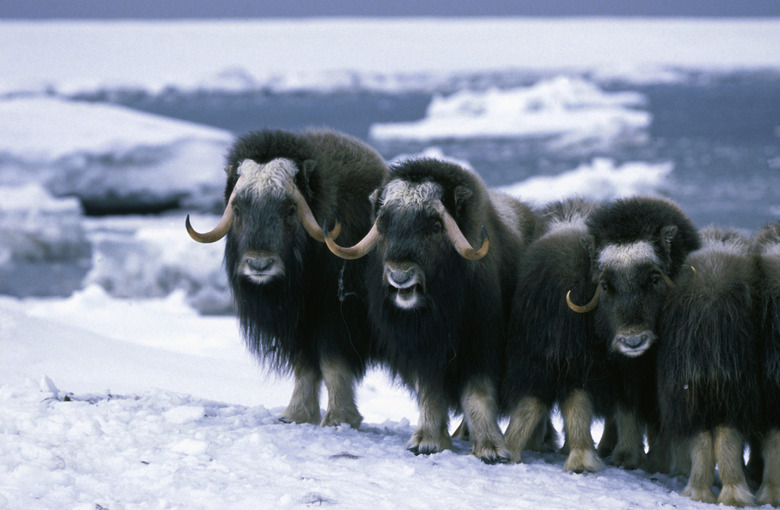Conservation Of Energy In The Tundra Biome
In places where energy and resources are scarce, organisms must find ways to compete or conserve energy in order to survive. Energy in an ecosystem exists in several forms, including heat and light energy from the sun; chemical energy in molecules, such as sugars, fats, proteins and carbohydrates; heat given off by organisms during metabolism and lost to the environment; and kinetic or motion energy. Conserving energy in an ecosystem can involve a variety of strategies on the part of organisms, including minimizing the loss of heat, storing chemical energy, maximizing the collection of solar energy and restricting movement.
Tundra Geography
Tundra Geography
The arctic tundra lies in regions just south of the north pole and north of the taiga or boreal forests, mostly between the latitudes of 55 and 70 degrees north. Some tundra-like places also exist near Antarctica, although they are always snow- or ice-covered and not true tundra. Because of the tilt of the Earth, the sun lies low on the horizon, and its rays must travel through more atmosphere before reaching the tundra, reducing the total solar energy. Summers in the Arctic tundra are short — only 50 to 60 days — but around the solstice, the sun shines 24 hours or nearly 24 hours a day. At that time, the tundra can receive as much solar energy as some tropical areas. Winter drags on long and dark, however, and days go by with almost no sun, or the sun rises just above the horizon for a few hours.
Tundra Climate
Tundra Climate
Because of the low solar radiation and geography, the tundra is extremely cold in winter (average -30 degrees F) and tends to be relatively cool (37 to 54 degrees F) in summer. Precipitation is low — only 4 to 10 inches per year — and usually falls as snow or ice. A permanently frozen sublayer of soil called permafrost makes drainage poor, and cold temperatures slow evaporation and decomposition, so much of the available energy and nutrients in the tundra exist in dead organic matter. During summer thaws, bogs appear, and a profusion of blooming plants, swarms of insects and millions of birds take advantage of the fleeting period of warmth to stock up on food. Before winter returns, some birds and mammals migrate south, but others stay to endure the darkness and frigid temperatures.
Conservation of Energy in Tundra Vegetation
Conservation of Energy in Tundra Vegetation
Tundra plants and other vegetation possess a number of adaptations to the cold, wind and low solar energy. They tend to be small and grow low to get warmth from the ground, such as lichen and mosses; they are dark in color — sometimes red — to better absorb sunlight; they concentrate much of their biomass and food storage in roots underground, where it is warmer; they can photosynthesize, or harness the sun's energy, at low temperatures and low light; some, including arctic willow, have "hair"-covered leaves to trap in heat; and they may grow in clumps or mats to protect themselves from wind and cold, such as tufted saxifrage. Most tundra plants are perennials instead of annuals, keeping their leaves over the winter to save energy; and some have dish-shaped flowers that follow the path of the sun, concentrating the solar energy. Tundra plants also speed the reproduction process by budding or dividing instead of reproducing sexually, which would involve more time- and energy-consuming seed production. In addition, tundra snow helps insulate plants from the cold and wind.
Conservation of Energy in Tundra Animals
Conservation of Energy in Tundra Animals
Many tundra animals conserve heat energy through their body shape. Lemmings and bears, for example, are short and stocky with short tails, ears and limbs; a low surface-area-to-volume ratio means less heat escapes the body. Tundra mammals and some birds also have thick fur or feathers, multiple layers of fur, waterproof coats or feathers and/or feathers or fur on the undersides of their feet to keep warm. The arctic fox wraps its bushy tail around itself like a blanket when it sleeps, and grizzly and polar bears have a thick layer of fat or blubber under their skin, which they work hard to accumulate by gorging during the short summers. Many tundra animals are dark in color to absorb the sun's energy, although some turn white in winter to better evade predators. Interestingly, polar bear fur and skin are not actually white. The fur — which is hollow and insulates well — is clear, reflecting white light but allowing in most sunlight, which is absorbed by the black skin. In winter, grizzly bears and arctic ground squirrels conserve energy by going dormant in dens for up to six to eight months, caribou lower their metabolism, musk oxen limit their activity and mosquitoes replace the fluids in their bodies with a natural kind of antifreeze called glycerol to keep from freezing.
Cite This Article
MLA
Carter, Kari Norborg. "Conservation Of Energy In The Tundra Biome" sciencing.com, https://www.sciencing.com/conservation-energy-tundra-biome-24061/. 24 April 2017.
APA
Carter, Kari Norborg. (2017, April 24). Conservation Of Energy In The Tundra Biome. sciencing.com. Retrieved from https://www.sciencing.com/conservation-energy-tundra-biome-24061/
Chicago
Carter, Kari Norborg. Conservation Of Energy In The Tundra Biome last modified March 24, 2022. https://www.sciencing.com/conservation-energy-tundra-biome-24061/
